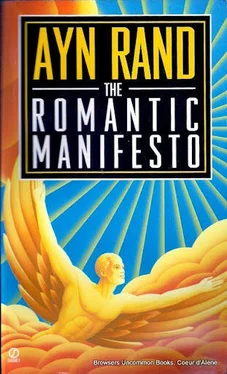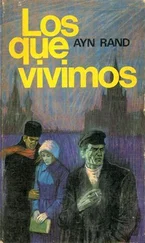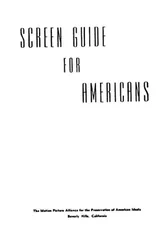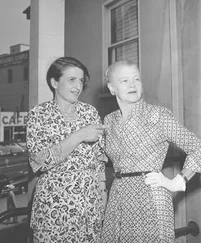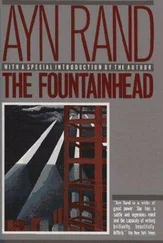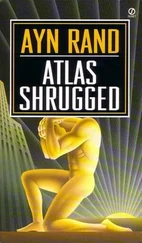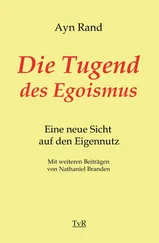Ayn Rand
THE ROMANTIC MANIFESTO
A Philosophy of Literature
Revised Edition
“THIS MANIFESTO IS NOT ISSUED IN THE NAME OF AN ORGANIZATION OR A MOVEMENT. I SPEAK ONLY FOR MYSELF. THERE IS NO ROMANTIC MOVEMENT TODAY. IF THERE IS TO BE ONE IN THE ART OF THE FUTURE, THIS BOOK WILL HAVE HELPED IT TO COME INTO BEING.”
THE dictionary definition of “manifesto” is: “a public declaration of intentions, opinions, objectives or motives, as one issued by a government, sovereign, or organization.” ( The Random House Dictionary of the English Language, College Edition, 1968.)
I must state, therefore, that this manifesto is not issued in the name of an organization or a movement. I speak only for myself. There is no Romantic movement today. If there is to be one in the art of the future, this book will have helped it to come into being.
According to my philosophy, one must not express “intentions, opinions, objectives or motives” without stating one’s reasons for them—i.e., without identifying their basis in reality. Therefore, the actual manifesto—the declaration of my personal objectives or motives—is at the end of this book, after the presentation of the theoretical grounds that entitle me to these particular objectives and motives. The declaration is in Chapter 11, “The Goal of My Writing,” and, partly, in Chapter 10, “Introduction to Ninety-Three. ”
Those who feel that art is outside the province of reason would be well advised to leave this book alone: it is not for them. Those who know that nothing is outside the province of reason will find in this book the base of a rational esthetics. It is the absence of such a base that has made today’s obscenely grotesque degradation of art possible.
To quote from Chapter 6: “The destruction of Romanticism in esthetics—like the destruction of individualism in ethics or of capitalism in politics—was made possible by philosophical default… . In all three cases, the nature of the fundamental values involved had never been defined explicitly, the issues were fought in terms of non-essentials, and the values were destroyed by men who did not know what they were losing or why.”
In regard to Romanticism, I have often thought that I am a bridge from the unidentified past to the future. As a child, I saw a glimpse of the pre-World War I world, the last afterglow of the most radiant cultural atmosphere in human history (achieved not by Russian, but by Western culture). So powerful a fire does not die at once: even under the Soviet regime, in my college years, such works as Hugo’s Ruy Blas and Schiller’s Don Carlos were included in theatrical repertories, not as historical revivals, but as part of the contemporary esthetic scene. Such was the level of the public’s intellectual concerns and standards. If one has glimpsed that kind of art—and wider: the possibility of that kind of culture—one is unable to be satisfied with anything less.
I must emphasize that I am not speaking of concretes, nor of politics, nor of journalistic trivia, but of that period’s “sense of life.” Its art projected an overwhelming sense of intellectual freedom, of depth, i.e., concern with fundamental problems, of demanding standards, of inexhaustible originality, of unlimited possibilities and, above all, of profound respect for man. The existential atmosphere (which was then being destroyed by Europe’s philosophical trends and political systems) still held a benevolence that would be incredible to the men of today, i.e., a smiling, confident good will of man to man, and of man to life.
It has been said and written by many commentators that the atmosphere of the Western world before World War I is incommunicable to those who have not lived in that period. I used to wonder how men could say it, know it, yet give it up—until I observed more closely the men of my own and the preceding generations. They had given it up and, along with it, they had given up everything that makes life worth living: conviction, purpose, values, future. They were drained, embittered hulks whimpering occasionally about the hopelessness of life.
Whatever spiritual treason they had committed, they could not accept the cultural sewer of the present, they could not forget that they had once seen a higher, nobler possibility. Unable or unwilling to grasp what had destroyed it, they kept cursing the world, or kept calling men to return to meaningless dogmas, such as religion and tradition, or kept silent. Unable to stifle their vision or to fight for it, they took the “easy” way out: they renounced valuing. To fight, in this context, means: to think. Today, I wonder at how stubbornly men cling to their vices and how easily they give up whatever they regard as the good.
Renunciation is not one of my premises. If I see that the good is possible to men, yet it vanishes, I do not take “Such is the trend of the world” as a sufficient explanation. I ask such questions as: Why?—What caused it?—What or who determines the trends of the world? (The answer is: philosophy.)
The course of mankind’s progress is not a straight, automatic line, but a tortuous struggle, with long detours or relapses into the stagnant night of the irrational. Mankind moves forward by the grace of those human bridges who are able to grasp and transmit, across years or centuries, the achievements men had reached—and to carry them further. Thomas Aquinas is one illustrious example: he was the bridge between Aristotle and the Renaissance, spanning the infamous detour of the Dark and Middle Ages.
Speaking only of the pattern, with no presumptuous comparison of stature intended, I am a bridge of that kind—between the esthetic achievements of the nineteenth century and the minds that choose to discover them, wherever and whenever such minds might exist.
It is impossible for the young people of today to grasp the reality of man’s higher potential and what scale of achievement it had reached in a rational (or semi-rational) culture. But I have seen it. I know that it was real, that it existed, that it is possible. It is that knowledge that I want to hold up to the sight of men—over the brief span of less than a century—before the barbarian curtain descends altogether (if it does) and the last memory of man’s greatness vanishes in another Dark Ages.
I made it my task to learn what made Romanticism, the greatest achievement in art history, possible and what destroyed it. I learned—as in other, similar cases involving philosophy—that Romanticism was defeated by its own spokesmen, that even in its own time it had never been properly recognized or identified. It is Romanticism’s identity that I want to transmit to the future.
As for the present, I am not willing to surrender the world to the jerky contortions of self-inducedly brainless bodies with empty eye sockets, who perform, in stinking basements, the immemorial rituals of staving off terror, which are a dime a dozen in any jungle—and to the quavering witch doctors who call it “art.”
Our day has no art and no future. The future, in the context of progress, is a door open only to those who do not renounce their conceptual faculty; it is not open to mystics, hippies, drug addicts, tribal ritualists—or to anyone who reduces himself to a subanimal, subperceptual, sensory level of awareness.
Will we see an esthetic Renaissance in our time? I do not know. What I do know is this: anyone who fights for the future, lives in it today.
All the essays in this book, with one exception, appeared originally in my magazine The Objectivist (formerly The Objectivist Newsletter ). The date at the end of each essay indicates the specific issue. The exception is “Introduction to Ninety-Three, ” which is a condensed version of the introduction I wrote for a new edition of Ninety-Three by Victor Hugo, translated by Lowell Bair, published by Bantam Books, Inc., in 1962.
Читать дальше
